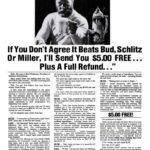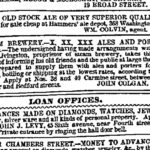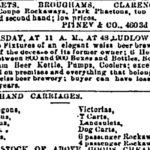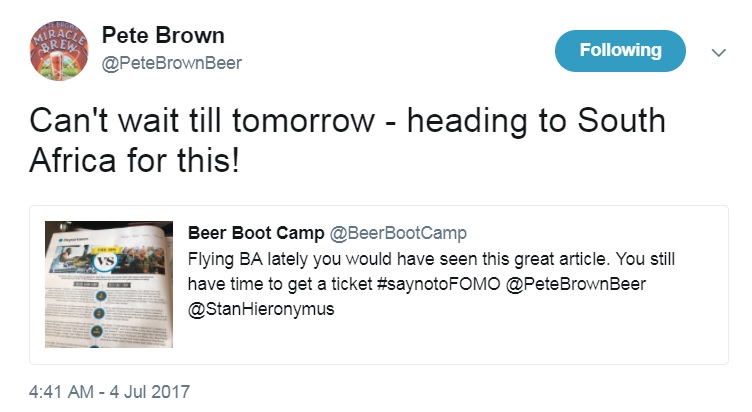
One of the interesting things about the language of beer is how little we think about it. Sure, there have been useful churnings over the origins of “craft“* and discoveries that before it became the popular term a little over a decade ago. But the reality is in the thirty plus years of this revival of good smaller scale brewing, “craft” is a word that has had its day. Refer to the new Brewers Association logo if you don’t believe me.
So, before we had craft when all the current commentators were still in high school we had micro brews made by micro brewing at micro breweries. But why? Why was “micro” the prefix of choice? The image above is a passage from that bedtime favourite Seminar on Micro-local Analysis by V. Guillemin, M. Kashiwara and T. Kawai published by Princeton University Press in 1979. “Micro” at that time was a science word. Which make sense given since at least the later 1800s interest in the microscope was a popular interest. In the book The Micro-macro Link by Jeffrey C. Alexander, published by University of California Press in 1987** the progression of the concept of “micro” is described in this passage in the introduction:
Although the micr0-macro theme has entered sociological theorizing as a distinct and firmly established issue only in recent decades, its prehistory can be traded from late medieval thinking through postwar meta-methodological debates over science, epistemology and political philosophy.
In brief, in the 1970s and early ’80’s the use of “micro” as a handy catch-all concept was relatively new. It appears to me that the route “micro” took from egghead to everyday was computing. We have the 1980 text Distributed Micro/Minicomputer systems: Structure, Implementation, and Application, for example, in which the future was described in this way:***
The continuing decline in processor and memory cost couples with the lower cost communications based on fiber optics, micro-wave transmission, and satellite communications, to use a few examples will hasten the development and widespread use of distributed systems based on micro- and minicomputer [technologies]…”
One is reminded of the SCTV character Gerry Todd from 1981-83 played by Rick Moranis to be brought back to the era when issues around what we might now call “personal” technology were sufficiently new and niche to be mocked.**** It is, in fact, always necessary to seek to place yourself back in a context when searching for a particular meaning. Otherwise, we are left with recollection and a lot of IMHOs which are often worse than useless. Fortunately, digital records give us a chance to reach back and pretend to relive the past – or at least can be used to cross reference the to often positive recollection.
Applying that principle, we see another interesting thing that is interesting for immediate purposes because it is included in the heading for this blog post.***** We see the words “micro” and “mini” bandied about. What did they mean in relation to the trendiest thing at this point in time? No, not beer… computers. Consider this articles in The Times Union of Albany, NY from March 11, 1986 under he title “Overbooked Libraries Seach for Space May Be Overdue”
At the central library of the Schenectady County Public Library across the street from City Hall, a space shortage has forced books to be stored on the second floor where administrative offices are located – off-limits to library patrons. Staff gofers bridge the gap between floors. “The lack of space is getting pretty serious,” said Ronald Lagasse, director of the Schenectady County Public Library. “The problem is we’ve had to increase the variety of formats of information we provide.” A micro-computer requires 200 feet, space the books used to get. Videocassette recorders, microfilm readers and printers and the storage for them have further eroded what was once the sole domain of books.
First, shoot the person who put that pun in the headline. Then – notice that “micro” was not very… micro. Now, look at this schedule of events and the mid-afternoon listing under the title “Wildlife Expo is Four Shows in One” published by the same paper five days later:
*2 p.m – Bruck Brodsky of Upstate Computer will feature “Home Use and Education With Micro and Mini Computers.” Attending this one will surely help you in the operation of many computers used throughout the Expo.
Hilary Dustin of U.S. Forest Service will lecture on the Finger Lakes National Forest.
“Micro” and “mini” are two things, two points on a scale. Why do we care about this? Because “micro” and “mini” brewing may also be a bit older than you realize. Look at these images:



The image to the left is a Schlitz ad from Schlitz ad found in Black Enterprise magazine’s October 1977 edition. A similar ad ran in U.S. News & World Report and Saturday Review in 1977 as well as Business Week in 1976. This use of “mini-brewery” was the same as Bert Grant’s Ontario-based pilot brewery operated first at Carling in the 1950s and then at his home in the early 1960s. See also Food Engineering, Volume 43 from 1971 which described producing beer in a “laboratory mini-brewery.” Scientific beer.
The other two images above are for another thing. They are ads for Bierhaus International’s “mini-brewery” as seen in Mother Jones Magazine Feb-Mar 1981 and Feb-Mar 1982 editions. Variations of the “Try My All Natural” advertising were also placed for years in magazines like in Kiplinger’s Personal Finance, Field and Stream, Popular Science and The Old Farmer’s Almanac. Tremendously manly and busy ads they are, too. I hope someone will be able to tell me about Bud Weckesser, the president of Bierhaus International Inc., if only because he clearly seems to be a man of international intrigue.† More to the point, he was selling a “mini-brewery” to subscribers of those fine journals. Science at home.
 Like the Schlitz and even Bert Grant’s pilot breweries, the Beerhaus International set ups were small. Small enough to fit in a home. Schlitz’s was only a five gallon set up providing “a world of care in miniature.” So you would think that “mini” is less than “micro” right? Not always. At least when it comes to brewing. Let’s have a look at that bit of the end of an article placed in the May 1982 edition of InfoWorld 17 magazine entitled “Micro Firms Vie for European Market at Hannover” in which the following is stated:
Like the Schlitz and even Bert Grant’s pilot breweries, the Beerhaus International set ups were small. Small enough to fit in a home. Schlitz’s was only a five gallon set up providing “a world of care in miniature.” So you would think that “mini” is less than “micro” right? Not always. At least when it comes to brewing. Let’s have a look at that bit of the end of an article placed in the May 1982 edition of InfoWorld 17 magazine entitled “Micro Firms Vie for European Market at Hannover” in which the following is stated:
You can take comfort from one thought in all this scale. Although Information Technology is growing incredibly, it is still not the biggest section in the seven-pound-plus Fair catalog (supplied with extra-strength handles). That is reserved for Electrical Engineering. When you reach the part of Fair reserved just for new railway locomotives, you begin to grasp that there are still worlds for the micro to conquer. There aren’t any micros used yet in the mini power station, not the mini brewery that run each year for only eight days in the Spring as part of the Fair on the flat German plains of Hannover.
It’s a delicious description of a transition point. [The heavy catalog has handles alone was worth the price of admission.] “Micros” are under too new to be pervasive but the “mini” brewery seems to have been around for yoinks. “Mini” is just small. “Micro” is both small and new.
So what happened to mini? As we see today with “independent” being proposed as the new “craft” just as “craft” was once the new “micro” we know these things are propped up and then later taken down once stale. But did “mini’ ever get its day in the sun? In the 1989 Canadian book Ale & Beer A Curious History by Alan D. Butcher published by then powerhouse bookseller McClelland & Stewart we read this lovely transitional passage:
…scores of other mini-breweries are also simply satisfying local tastes? Upper Canada Brewing, an Ontario-based “micro” brewery, sells across Ontario and has recently entered the European market.
 A few years earlier, the Australian publication Beverage Review appeared to use the term generously. In 1984, The Economist magazine’s Intelligence Unit published an issue on retail business which contained the description to the right. It describes a Whitbread pub, the still operating Alford Arms, as then having a brewing set up in house. A mini-brewery appears in this context to refer to the equipment more than perhaps than the business model. Similarly, in a 1986 publication from the apartheid era South African Information Service South African Panorama a similar description is used:
A few years earlier, the Australian publication Beverage Review appeared to use the term generously. In 1984, The Economist magazine’s Intelligence Unit published an issue on retail business which contained the description to the right. It describes a Whitbread pub, the still operating Alford Arms, as then having a brewing set up in house. A mini-brewery appears in this context to refer to the equipment more than perhaps than the business model. Similarly, in a 1986 publication from the apartheid era South African Information Service South African Panorama a similar description is used:
Barney’s Tavern and Heritage Brewery, which are administered by South African Breweries. The beer is brewed on site and Is called Digger’s Draught. The brewery is the only fully-fledged mini brewery of Its kind in South Africa.
The term shows up in the USA as well. A 1986 article on plans for Kentucky’s first micro, the Oldenburg Brewery, stated that it:
…will be a mini-brewery licensed under the new Kentucky microbrewery law enacted by the legislature in 1984. The brewery will have a limited capacity of 12,500 barrels of traditional German beer made only with malted barley and hops …
And in the 1982 travel guide Making the most of Sonoma: a California guide by Don Edwards we read one of the founding American micros being described in this way:
A wine country mini-brewery, New Albion, produces traditional British-style ale, porter, and stout— all good companions to Sonoma’s cheese, bread, and sausage.
And then? Not so much more. “Micro” soon starts to go macro as the inevitable dreams start to kick in. It then reigns for the best part of twenty years before it became clear that micros were not going to be in view of mini in the future. Change and growth occur. The idea that New Albion might lead to international scale big craft would have seemed very much a dream (if not a farce) to those sipping a stout with their Sonoma bread and sausage. Language needs to compete, keep up or fall away. “Mini” just never really got very deep into that game.
*Which includes some of the best sources ever including this clever one: “New Belgium is one of several breweries Alan McLeod, co-author of The Unbearable Nonsense of Craft Beer—A Rant in Nine Acts, describes as big craft. “What bugs me about ‘craft beer’ as a term is that it arose to cover up that micro beer was less and less crafted and more and more industrialized. It is double speak,” he wrote via email. “… New language was required to mask the industrialization and then nationalization of what is now big craft.”“
**Note obvious use of egghead texts found on Google Books to laydown a questionable baseline of cleverness.
***Interestingly, a now charming foreshadowing of only the nonthreatening parts of the argument of “Why the Future Does Not Need Us” from 2000. I actually cited this in my 2000-2001-ish LLM thesis so I don’t feel entirely dirty writing this footnote.
****But were more likely then thought of as “home” technology. Note: I also still have my rude 45 of “Turning Japanese”… so there.
*****You don’t post a blog. You post a blog post to a blog. Blog is short for “web log” which makes it a log and a log has entries. A log is not each entry. It is the total of all entries. A blog is not each post.
†More here.
 It all got messy mid-week. It was looking dull and then a number of big things happened. More about those things later. The best thing, a littler thing, is not really one of note – it’s that Ron wrote a few travel posts as he wandered about England as a Goose Island consultant. Not that I mind his recipes and quotations from rulings of the magistrate’s court circa 1912 but his real gift is capturing the normal life of a guy and his problem with beer. Consider the gorgeous photo he attached to one post which I have pilfered and plunked right there. I have dubbed it “Ronnui“: lovely wood and glass inside with unloveliness outside and across the road. And a man considering the emptiness of it all. You sense that even the umbrella he brought won’t be enough. A fire extinguisher serves as a warning to you. Not the sort of thing you’ll see in one of the new dipso guides to global vagrancy. Editors don’t like that sort of detail. No, this is honest stuff. Click on the image, look upon Ron’s work and despair.
It all got messy mid-week. It was looking dull and then a number of big things happened. More about those things later. The best thing, a littler thing, is not really one of note – it’s that Ron wrote a few travel posts as he wandered about England as a Goose Island consultant. Not that I mind his recipes and quotations from rulings of the magistrate’s court circa 1912 but his real gift is capturing the normal life of a guy and his problem with beer. Consider the gorgeous photo he attached to one post which I have pilfered and plunked right there. I have dubbed it “Ronnui“: lovely wood and glass inside with unloveliness outside and across the road. And a man considering the emptiness of it all. You sense that even the umbrella he brought won’t be enough. A fire extinguisher serves as a warning to you. Not the sort of thing you’ll see in one of the new dipso guides to global vagrancy. Editors don’t like that sort of detail. No, this is honest stuff. Click on the image, look upon Ron’s work and despair.


















